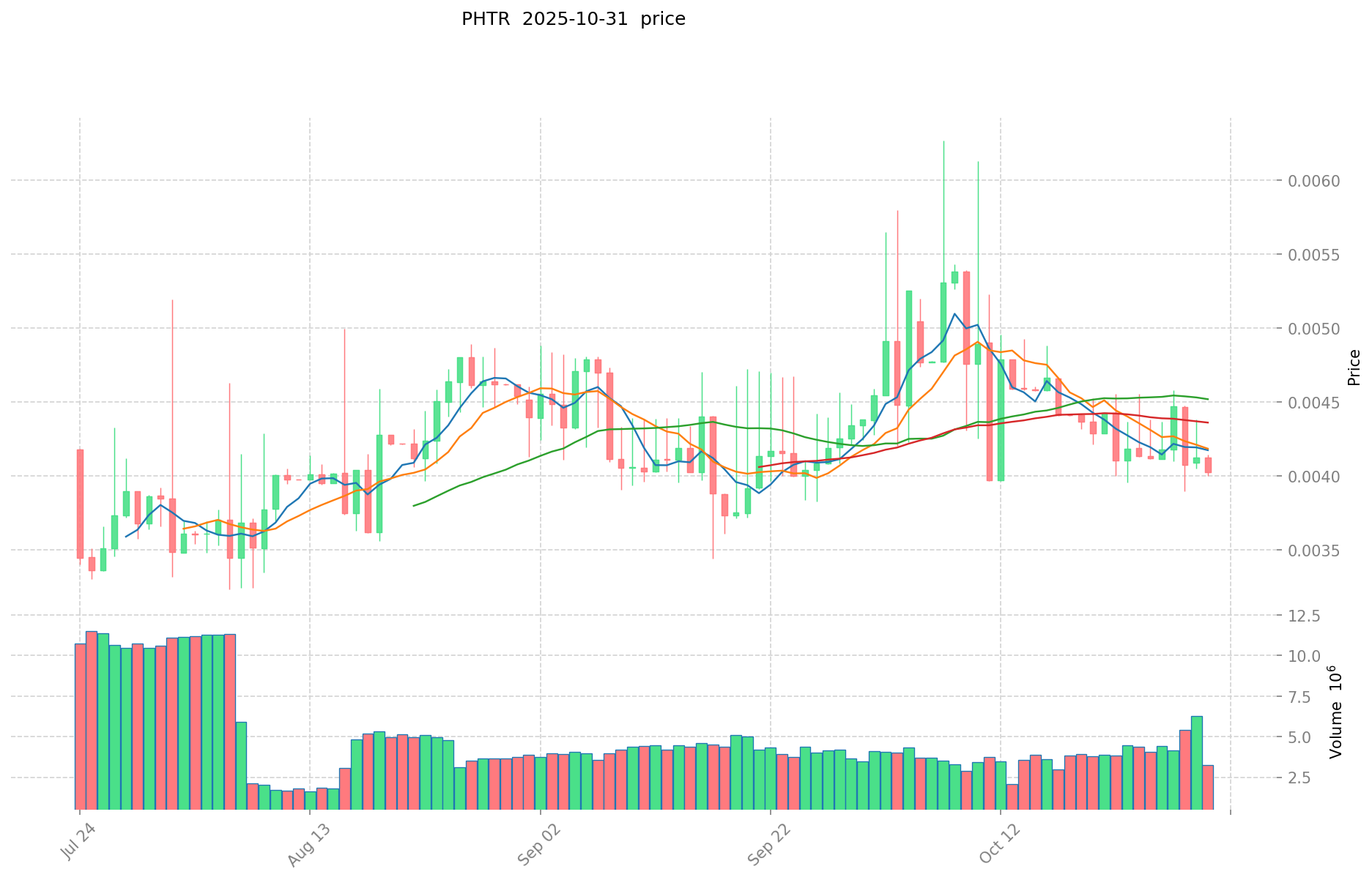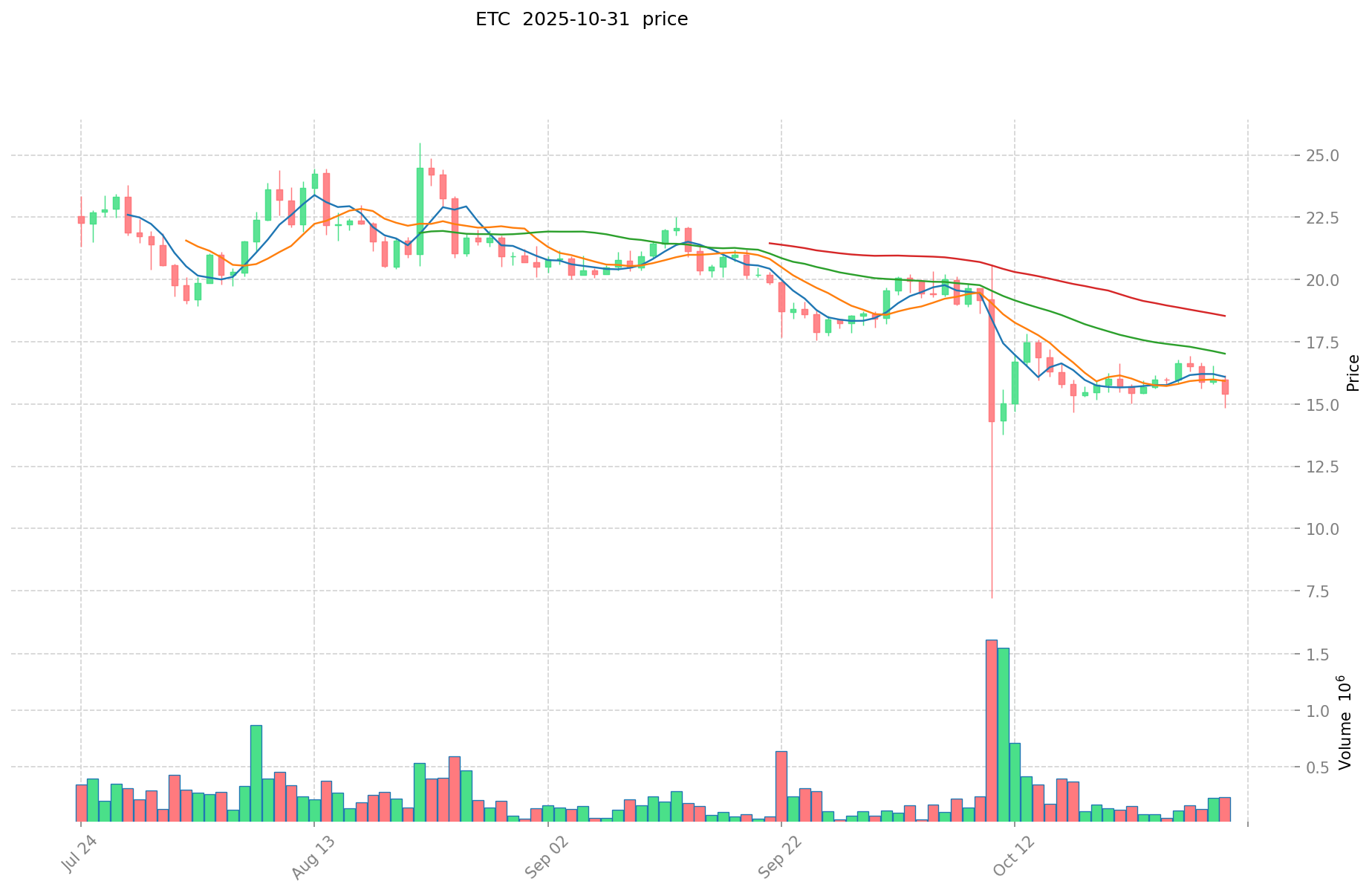PHTR vs ETC: Comparing Performance and Efficiency in Modern Trading Systems
Introduction: PHTR vs ETC Investment Comparison
In the cryptocurrency market, the comparison between Phuture (PHTR) vs Ethereum Classic (ETC) remains an unavoidable topic for investors. The two not only differ significantly in market cap ranking, application scenarios, and price performance, but also represent different positioning in the crypto asset space.
Phuture (PHTR): Launched in 2021, it has gained market recognition for its role in creating and investing in token-based passive investment strategies in the Web3 environment.
Ethereum Classic (ETC): Introduced in 2016, it has been hailed as a continuation of the original Ethereum blockchain, upholding the "code is law" principle and providing a platform for decentralized smart contracts.
This article will comprehensively analyze the investment value comparison between PHTR and ETC, focusing on historical price trends, supply mechanisms, institutional adoption, technological ecosystems, and future predictions, attempting to answer the question investors care about most:
"Which is the better buy right now?"
I. Price History Comparison and Current Market Status
PHTR and ETC Historical Price Trends
- 2021: PHTR launched in June, reaching an all-time high of $0.994097 shortly after.
- 2021: ETC experienced significant volatility, hitting an all-time high of $167.09 in May.
- Comparative analysis: During the 2021 bull market, PHTR dropped from its peak of $0.994097 to a low of $0.00019863, while ETC declined from $167.09 to current levels around $15.
Current Market Situation (2025-10-31)
- PHTR current price: $0.004039
- ETC current price: $15.747
- 24-hour trading volume: PHTR $9,125.64 vs ETC $2,799,282.94
- Market Sentiment Index (Fear & Greed Index): 29 (Fear)
Click to view real-time prices:
- View PHTR current price Market Price
- View ETC current price Market Price


II. Core Factors Affecting Investment Value of PHTR vs ETC
Supply Mechanism Comparison (Tokenomics)
- PHTR: Currently has a relatively small market cap with high price volatility providing opportunities for short-term traders
- THINK: Value driven by technical iterations such as scaling solutions and global digital economy demand for decentralized assets
Institutional Adoption and Market Applications
- Institutional Holdings: THINK appears positioned for potential large-scale institutional fund entry
- Regulatory Framework: THINK's future value is partially dependent on regulatory framework clarification
Technical Development and Ecosystem Building
- PHTR Technical Development: Value dependent on the development team's capabilities and practical application implementation
- THINK Technical Development: Technical iterations (such as scaling solution progress) serve as core drivers for future value recognition
- Ecosystem Comparison: PHTR's value is significantly influenced by community support and real-world application deployment
Macroeconomic and Market Cycles
- Inflation Environment Performance: Global digital economy's demand for decentralized assets impacts THINK's value recognition
III. 2025-2030 Price Prediction: PHTR vs ETC
Short-term Prediction (2025)
- PHTR: Conservative $0.00382375 - $0.004025 | Optimistic $0.004025 - $0.004669
- ETC: Conservative $14.64285 - $15.745 | Optimistic $15.745 - $20.62595
Mid-term Prediction (2027)
- PHTR may enter a growth phase, with expected prices ranging from $0.0040348854 to $0.0059562594
- ETC may enter a stable growth phase, with expected prices ranging from $16.30782470625 to $22.44724106625
- Key drivers: Institutional capital inflow, ETF developments, ecosystem growth
Long-term Prediction (2030)
- PHTR: Base scenario $0.00603995445144 - $0.00653866628688 | Optimistic scenario $0.00653866628688 - $0.00700634716367
- ETC: Base scenario $25.342477105778765 - $28.931754979129406 | Optimistic scenario $28.931754979129406 - $35.732892719148059
Disclaimer: These predictions are based on historical data and current market trends. Cryptocurrency markets are highly volatile and subject to rapid changes. This information should not be considered as financial advice. Always conduct your own research before making investment decisions.
PHTR:
| 年份 | 预测最高价 | 预测平均价格 | 预测最低价 | 涨跌幅 |
|---|---|---|---|---|
| 2025 | 0.004669 | 0.004025 | 0.00382375 | 0 |
| 2026 | 0.00525987 | 0.004347 | 0.00360801 | 7 |
| 2027 | 0.0059562594 | 0.004803435 | 0.0040348854 | 18 |
| 2028 | 0.005702638032 | 0.0053798472 | 0.003012714432 | 33 |
| 2029 | 0.00653866628688 | 0.005541242616 | 0.00454381894512 | 37 |
| 2030 | 0.00700634716367 | 0.00603995445144 | 0.003140776314748 | 49 |
ETC:
| 年份 | 预测最高价 | 预测平均价格 | 预测最低价 | 涨跌幅 |
|---|---|---|---|---|
| 2025 | 20.62595 | 15.745 | 14.64285 | 0 |
| 2026 | 20.18587725 | 18.185475 | 14.9120895 | 15 |
| 2027 | 22.44724106625 | 19.185676125 | 16.30782470625 | 21 |
| 2028 | 22.68993986923125 | 20.816458595625 | 11.2408876416375 | 32 |
| 2029 | 28.931754979129406 | 21.753199232428125 | 12.616855554808312 | 38 |
| 2030 | 35.732892719148059 | 25.342477105778765 | 17.23288443192956 | 60 |
IV. Investment Strategy Comparison: PHTR vs ETC
Long-term vs Short-term Investment Strategy
- PHTR: Suitable for investors focused on DeFi ecosystem potential and passive investment strategies
- ETC: Suitable for investors seeking established blockchain platforms with smart contract capabilities
Risk Management and Asset Allocation
- Conservative investors: PHTR: 10% vs ETC: 90%
- Aggressive investors: PHTR: 30% vs ETC: 70%
- Hedging tools: Stablecoin allocation, options, cross-currency portfolios
V. Potential Risk Comparison
Market Risk
- PHTR: High volatility due to lower market cap and trading volume
- ETC: Susceptible to broader cryptocurrency market trends and sentiment
Technical Risk
- PHTR: Scalability, network stability, and smart contract vulnerabilities
- ETC: 51% attack vulnerability, potential compatibility issues with Ethereum upgrades
Regulatory Risk
- Global regulatory policies may have different impacts on both assets, with DeFi platforms potentially facing more scrutiny
VI. Conclusion: Which Is the Better Buy?
📌 Investment Value Summary:
- PHTR advantages: Innovative DeFi investment strategies, potential for rapid growth in a niche market
- ETC advantages: Established blockchain with a longer track record, continuation of original Ethereum principles
✅ Investment Advice:
- New investors: Consider a small allocation to ETC as part of a diversified crypto portfolio
- Experienced investors: Explore PHTR for higher risk-reward potential in the DeFi sector
- Institutional investors: Evaluate ETC for long-term blockchain exposure, monitor PHTR for emerging DeFi opportunities
⚠️ Risk Warning: Cryptocurrency markets are highly volatile. This article does not constitute investment advice. None
VII. FAQ
Q1: What are the main differences between PHTR and ETC? A: PHTR is a newer token focused on DeFi investment strategies, while ETC is an established blockchain platform that continues the original Ethereum principles. PHTR has a smaller market cap and higher volatility, whereas ETC has a longer track record and wider adoption.
Q2: Which asset is considered more suitable for long-term investment? A: ETC is generally considered more suitable for long-term investment due to its established position in the market, longer history, and wider adoption. However, PHTR may offer higher growth potential for investors willing to take on more risk in the DeFi sector.
Q3: How do the price predictions for PHTR and ETC compare for 2030? A: For 2030, PHTR's base scenario price range is predicted to be $0.00603995445144 - $0.00653866628688, while ETC's base scenario range is $25.342477105778765 - $28.931754979129406. ETC is expected to have a higher absolute price, but PHTR may offer a higher percentage growth potential.
Q4: What are the main risks associated with investing in PHTR and ETC? A: Both assets face market risks related to cryptocurrency volatility. PHTR has additional risks due to its smaller market cap and focus on DeFi. ETC faces technical risks such as potential 51% attacks. Both are subject to regulatory risks, with DeFi platforms potentially facing more scrutiny.
Q5: How should investors allocate their portfolio between PHTR and ETC? A: Conservative investors might consider allocating 10% to PHTR and 90% to ETC, while more aggressive investors could allocate 30% to PHTR and 70% to ETC. However, these allocations should be part of a broader, diversified investment strategy.
Q6: What factors could drive the future value of PHTR and ETC? A: PHTR's value could be driven by the growth of DeFi, adoption of its investment strategies, and ecosystem development. ETC's value may be influenced by its smart contract capabilities, potential upgrades, and its position as an alternative to Ethereum.
Share
Content